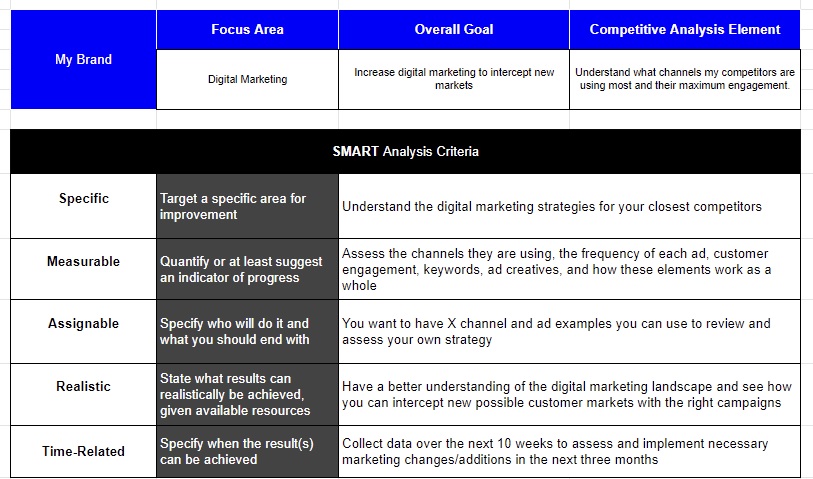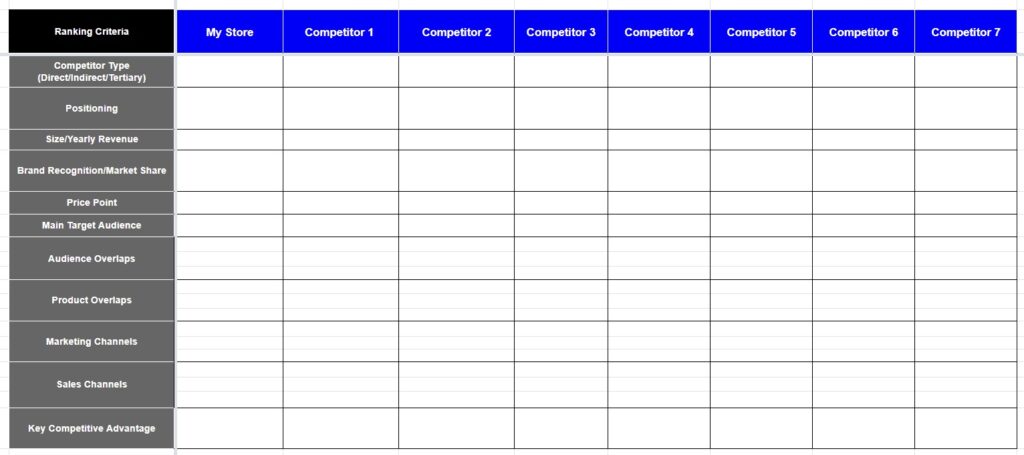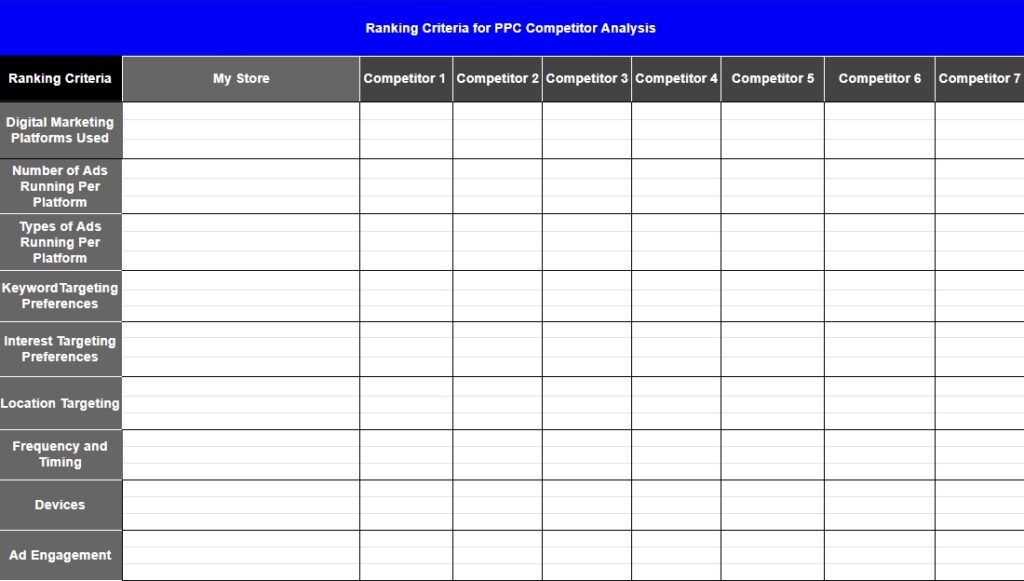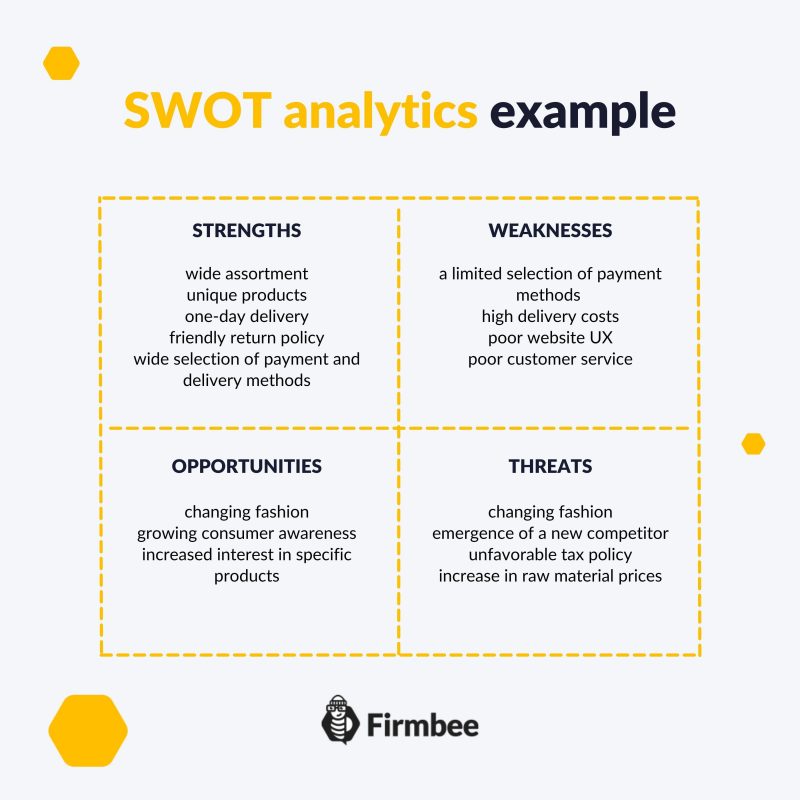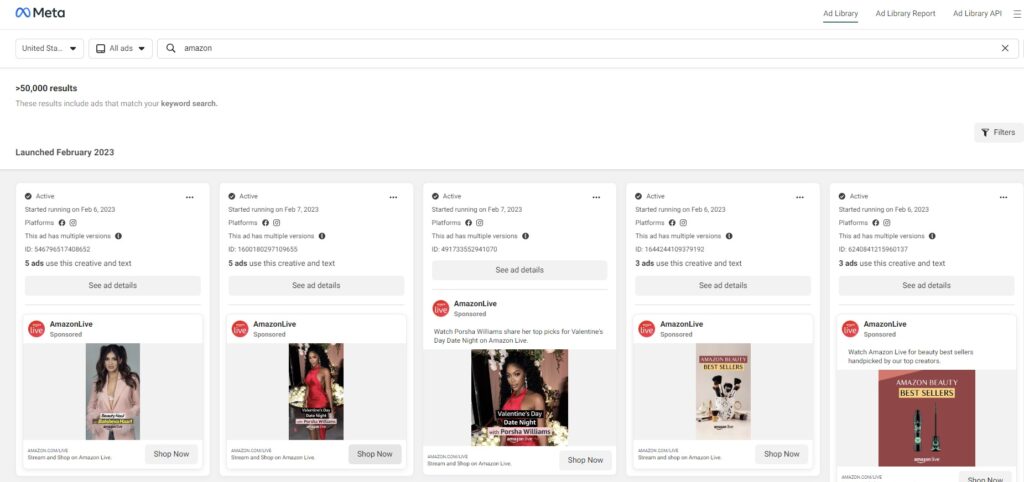Want to scale and dominate? Then this eCommerce Competitor Analysis Template is a must.
Even if you think your niche is, well, niche, it may not be for long. According to current estimates, there are up to 24,000,000 online stores across the entire globe — and that number is only growing.
This means it’s never been more critical than now to stay ahead of your competitors. And you can’t do that if you don’t know precisely what they are doing for everything from audience targeting and product positioning to content marketing and product photography.
And what is the optimum way to do that? We’ve got you covered.
This post gives you everything you need to understand, conduct, and assess an eCommerce competitor analysis. (Feel free to click on TOCs below to skip ahead.)
eCommerce Competitor Analysis Guide
But first, let’s very quickly recap what a comprehensive eCommerce competitive analysis is.
What Is a Competitor Analysis?
A competitor analysis is a deep dive into every aspect of your closest competitors.
Sometimes referred to as a competitive analysis, with this competitive strategy, your aim is to compare a strong competitor to yourself in terms of marketing, products, positioning, pricing, and audiences — all to assess their (and your!) strengths and weaknesses. You can achieve this by collecting essential data points and market metrics, and then creating a SWOT analysis.
By doing this with multiple competitors for different business aspects, you will see how your product and brand could not only improve but cash in on areas where your competitor is lacking.
Right, let’s dive in!
1. Why You Need to Regularly Conduct a Competitor Analysis for Your Online Store
Competitor analysis is vital if you want to fully understand your market and how you fit into your niche.
Why?
It’s impossible to effectively compete if you don’t have a clear understanding of how you can adapt your brand messaging to differentiate and dominate.
Conducting a regular competitor analysis will help you:
- Spot new emerging customer bases
- Strengthen your brand or product’s unique value proposition
- Identify new market trends
- Reframe benchmarks against the most significant competitors
- Reevaluate pricing
- Find marketing gaps and opportunities
Bonus Content: How to Spy on Your Competitors on Facebook
Your competitor analysis reports will ultimately enable you to stay one step ahead of the competition and market changes.
2. Competitive Analysis Example: A Breakdown
A competitive analysis will vary from brand to brand.
This means that even if you’re using a competitive analysis template or blueprint to do your analysis, it should be unique to your specific market, niche, and brand. You can also do different competitive analyses for specific aspects such as store design and UX or digital product marketing.
Whether you need a detailed, in-depth metric-centric brand target market analysis or a quick marketing overview, the opportunities are endless.
However, one thing is standard: You’re looking to understand how your brand fits in your market for the specific aspects you’re looking to dominate in — all to reach new potential customers.
That being said, let’s look at what a generalized high-level competitor analysis would look like if you wanted to assess significant aspects of competitors and how you’re positioned in your niche.
Example of Competitive Analysis Questions
Firstly, it’s important to define the questions you want your competitive analysis to answer. These include, but are not limited to:
- Who are your main competitors?
- What is each brand’s unique value proposition or main differentiator?
- Who is their ideal target audience?
- What key product features do they include in their main messaging?
- How do they approach shipping and fulfillment?
- What digital channels do they market on?
- How does their store rank in terms of SEO?
- What are their customers saying about them?
Example of Competitive Analysis Sections / Elements
As you will see in the step-by-step guide to creating your eCommerce competitor analysis template below — the elements you assess will depend on your objectives and goals. However, let’s look at some general areas where you are likely to want to compare your competitors’ approaches to your own.
- Shopping experience elements, such as checkout and support workflows and strategies
- Store website layout and design elements, such as product page optimization and competitors website navigation
- Brand voice, messaging, and copywriting approaches
- Marketing strategies and tactics, such as PPC channels and messaging and promotion strategies
- Email marketing strategies and frequencies
- Social media and content marketing elements, such as blog content strategies and social engagement
- Customer reviews and ratings, recurring complaints, and customer support
- Main sales channels, such as your competitor’s website, marketplaces, and social media shops
3. Difficulties and Sidenotes with a Marketing Competitor Analysis
Before we take you through every step needed to create a functional competitor analysis template for your niche, it’s important to point out some analysis pitfalls to be aware of — especially with regard to marketing.
Let’s break them down.
Don’t Start Your Competitor Analysis Without a Set Directive
Putting together your competitive analysis before you have outlined your goals and objectives is far from ideal. Not only will it make the analysis harder to do, but it will likely leave you with holes in your data. Data that you need to dominate your niche.
Without Action, Your Analysis Data is Useless
If you’re going to commit to strategically creating a customer analysis template, make sure you back up your data assessments with action. This means:
- Summarizing your findings (through a SWOT analysis)
- Creating strategies around vital metrics
- Finding ways to execute tactics and putting these strategies into action
Always Take Time Frames into Consideration
Sometimes, how a brand got from point A to point B is far more valuable than the fact that they are at point B.
You don’t want to just look at a current snapshot of your market and competitors as they compare to you right now. Instead, you will want to take a deeper look into each element you’re assessing to see how they progress or grew over an extended period of time.
The idea is to compare growth trajectories as well as being able to access possible opportunities in competitor data.
Watch Out for Confirmation Bias
It’s common to make quick assumptions without looking deep into the data enough before making conclusions. Referred to as “confirmation bias,” you can overcome this by testing your findings and conclusions before you use them to adjust your strategy.
Like with any analysis, you want to ensure that you are collecting tangible data and using that data to drive decisions.
Work Smarter, Not Harder
Yes, you want to start with a solid foundation and template to ensure your comparisons are not only easier but as accurate as possible.
But you also want to ensure you are collecting the correct data to begin with. This can be time-consuming without the right tools.
(You will find a helpful list below in the Competitor Analysis Tools for Easier Data Collection section of this post.)
Competitive Analysis Is Not a Once-Off, One-Size-Fits All Assessment
Doing an eCommerce competitor analysis is not a once-off necessity. It is something you want to be regularly doing to ensure you are keeping up with evolving market trends and new online retail competition. You also want to repeat this for different aspects and shifting goals.
Furthermore, there is no one-size-fits-all for a good analysis. Every brand, market, niche, and audience differs. This is why it’s vital to build a good competitor analysis template designed specifically for your brand and industry that you can then adjust as shifts occur.
Pro Tip. Are you looking for real-time competitor analysis results without having to wait for a complete competitor analysis? Then you should check out these two free tools that give you key results in minutes.
- Growth Hero. Growth Hero will audit your Meta Ads account for free and give you expert improvements, valuable insights, and optimization tips.
- Benchmark Hero. This free audit tool will automatically compare your web store to thousands of large stores to quickly and effectively pinpoint what you can easily do to improve your store today!
4. How to Build a Competitor Analysis Template in 8 Steps
To build a good competitor analysis template for your reporting, you will want to:
- Download and edit this eCommerce Competitor Analysis Template Google Sheet
- Set your competitor analysis template goals
- Choose your key competitors
- Define your competitive ranking criteria and custom fields
- Drill down your competitors’ product positioning
- Evaluate how your competitors are marketing themselves and their products
- Assess your competitor data and do a full SWOT analysis
Let’s look deeper into each.
Step #1: Download and Edit This eCommerce Competitor Analysis Template Google Sheet
The first thing you want to do is download this free competitor analysis template that you can edit and adapt to suit your brand, business, and goal.
Now, let’s get into the nitty-gritty!
Step #2: Set Your Competitor Analysis Template Goals
In a general sense, the main goals of a good competitor analysis are determining how you can stand out, having a clearer understanding of what actions your competitors are taking, and determining your — and their — comparative advantages.
But you need to drill it down so that it’s less generic and more customized to your specific needs. Are you looking to streamline your sales funnel and digital marketing?
Or perhaps you want to compare overall positioning to find ways to adjust your on- or off-site messaging to stand out better?
Therefore, before creating your competitor analysis blueprint, you want to flesh out the overall goals. By knowing exactly what you want to achieve, you will be able to reverse engineer the data you need to collect and the conclusions you need to draw to get you there.
A good way to do this is using the SMART criteria. Here’s an example from our Competitor Analysis Template download.
Step #3: Choose Your Key Competitors
Next, you will want to research and identify the most relevant competitors to use in your analysis. This means finding competitors who sell a similar product to you, yet to slightly different target audiences.
Ideally, you want to put together a diverse group of direct and indirect competitors (7–10) to give you a clear idea of the market.
Categorizing Competitor Types
When choosing and adding competitors to your Google sheet, you will want to separate them into the types of competitors they are. These include:
- Direct/primary competitors. These are retail competitors that sell similarly related products to a close audience. For example, McDonald’s and Burger King are direct competitors.
- Indirect/secondary competitors. These are retail competitors that offer a different version of your category list to a different audience. It’s likely that you’re both offering conflicting product solutions for the same customer need. For instance, McDonald’s and an online snack store would be a direct competitor to each other — both providing food for their customer’s hunger needs.
- Tertiary competitors. These are eCommerce brands that sell totally different products than you but to the same market you’re looking to target. Generally, these types of competitors have the potential to make good brand partners for co-marketing collaborations.
Some ways you can find different types of competitors include doing:
- Keyword research
- Market research
- Customer feedback canvassing
- Social media and forum research and Q&As
- Google search research
Step #4: Define Your Competitive Ranking Criteria and Custom Fields
The next step is to define the ranking criteria of your competitor analysis sheet. This will ensure the data you collect will lead to the conclusions you need to reach your goals. Because of this, the ranking criteria will be slightly different for every eCommerce competitor analysis template.
However, here are some general criteria we included in the template to get you started:
- Competitor Type (Direct/Indirect/Tertiary). Here you define what type of competitor the eCommerce brand is in your analysis.
- Positioning. This is where you highlight the brand or product positioning for yourself and your key competitors.
- Brand Recognition or Market Share. Here you will want to note the market share or brand recognition metrics of your eCommerce competitor analysis.
- Size/Yearly Revenue. Here you can compare the size or the yearly revenue of each competitor to your brand.
- Price Point. This is where you can input the average price point for products in order to compare markets.
- Main Target Audience. This is where you define the main target audience for all the brands in your competitor analysis.
- Audience Overlaps. Here you compare key segments where a competitor’s audience overlaps with yours.
- Product Overlaps. This is where you note and input any similar products.
- Marketing Channels. Here you note all the marketing channels you and your competitors are using.
- Sales Channels. This is where you list each of your indirect or direct competitor’s sales channels.
- Key Competitive Advantage. Here you summarize the competitive advantage each brand has once you have revised the data imputed in each custom field.
However, as we mentioned, you don’t want your competitor analysis to be general. So, you will need to adjust these competitor custom fields depending on your goals.
Here are some examples.
Competitive Ranking Examples
For instance, let’s say you want to improve your store’s ranking; you will want to add related custom fields, such as:
- Traffic and visibility
- Store site ranking
- Content type
- Keywords
- Backlinks
…and more!
Or, let’s say you want to do a competitor analysis before upgrading your product photography or product page design. Then, you would want to include ranking criteria such as:
- Usage and display
- Product page layout and design
- Number of images
- Product videos
Lastly, let’s say you want to compare your brand’s PPC marketing to those of your key competitors. Then your assessment criteria might look a little something like the list below.
Ranking Criteria for PPC Competitor Analysis
- Digital marketing platforms used
- Number of ads running per platform
- Types of ads running per platform
- Keyword targeting preferences
- Interest targeting preferences
- Location targeting
- Frequency and timing
- Devices
- Ad engagement
You can also find these in the third sheet of the eCommerce Competitor Analysis Template, which you can download here.
Step #5: Drill Down Your Competitors’ Product Positioning
Whether you’re doing a quick general market competitor analysis or an in-depth social media analysis, how your competitor positions themselves or a specific product is very important.
Why? Positioning will help you determine their core messaging and how potential customers are responding to them.
This ultimately helps you identify your competitors’ positioning and see how you can not only separate your brand from them but improve on it to stand out in your niche.
Here are some questions you can ask yourself when drilling down and researching your competitor’s positioning.
- Have you defined your value proposition?
- What stories do they highlight for their customers?
- Have you checked their key social media channels and messaging?
- How do they position themselves and their products through their website copy and product descriptions?
- What is the key feature they are highlighting, or their main products?
- How are they interacting with their customers, followers, fans, and even teams?
Step #6: Evaluate How Your Competitors Are Marketing Themselves and Their Products
Another important step in doing your competitor analysis is reviewing other top stores’ marketing. Having a good understanding of how your direct and indirect competitors market themselves and their products will help you find ways to fill the gaps. This isn’t just PPC and social media marketing. You want to look at all on- and off-site marketing as a whole.
Here is a breakdown of what you should be reviewing:
- Email marketing. Review every aspect of their email marketing. You can do that by signing up for each competitor’s email list and reviewing their newsletters. Or by taking action on their site by putting things in their cart and triggering abandonment emails to compare.
- Content marketing. Sign up and review your competitors’ blog content. What are they writing about? Where are they sharing it?
- Social media marketing. Become your competitor’s fans and followers on social media to receive their content and marketing. What content are they posting, and how often are they posting?
- Remarket PPC. Spend some time on their product pages and then search for products on Google, or visit social channels to review remarketing ads.
- Post-sale marketing. Purchase a product on their store to review after-sales service and promotions.
- Organic search marketing. Use tools like Arefs to see which of their pages are performing well in terms of organic search.
- On-site marketing. What promotions are they running on their site, and when? How does it flow and move customers to the checkout page?
Step #7: Assess Your Competitor Data and Do a Full SWOT Analysis
Once you have defined your goals and set and collected data based on the needed criteria, you will want to fully analyze the data to look for areas where your brand is stronger or weaker so that you can take action.
In other words, you will want to do a SWOT analysis. This is where you look at your competitor analysis data to review and summarize your brand’s and competitor’s strengths, weaknesses, opportunities, and threats. Like this example does.
[Source: Firmbee]
Here’s a breakdown of what you’re looking for:
- Strengths. What are the key competitor analysis areas or data points that your brand outperforms in?
- Weaknesses. Where in your competitor analysis is your brand lagging behind? What is your biggest weakness for each custom field?
- Opportunities. What are the data points where your key competitors excel that your store isn’t tackling yet?
- Threats. Which areas in your analysis data show your brand is threatened?
[Bonus Video] How to Conduct a Competitive Analysis for Your Business
Here’s a full video breakdown you can use to build and conduct a competitive analysis the right way.
5. Competitor Analysis Tools for Easier Data Collection
Now that we know why you need eCommerce competitor analysis and how to do it, let’s quickly look at some tools you can use for data collection.
Competitor Market Analysis Tools
- Benchmark Hero. This tool will automatically compare your web store to thousands of large stores to quickly and effectively pinpoint what you can easily do to improve your store today.
- Owler. This tool enables you to automatically track a personalized database of companies by a variety of criteria as well as follow market and industry trends.
SEO Competitor Analysis Tools
- MozBar. The MozBar Chrome extension gives you great SEO competitor research data straight from the browser.
- Semrush. Another SEO analysis tool worth looking into is Semrush. Semrush enables you to track positions and does full SEO audits.
- Ahrefs. Ahrefs is great for auditing your own and your competitor’s website and enables you to review top-performing organic keywords.
- SE Ranking. This is a full SEO analysis and marketing tool that enables you to track keyword ranking and your competitor’s organic SEO campaigns.
Bonus Content: Leading PPC Management Software and Keyword Research Tools
Email Marketing Competitor Analysis Tools
- Owletter. This tool will automatically capture and analyze all emails sent from a competitor’s website to their mailing list.
- MailCharts. MailCharts is an email analysis tool that collects frequency, subject, design trends, etc., to show how your marketing compares.
Content Marketing Competitor Analysis Tools
- Similarweb. This tool analyzes your competitive landscape and can be used to gather SEO and content marketing data.
- BuzzSumo. One of BuzzSummo’s many product features is the ability to search a competitor’s domain to uncover their top content.
- Feedly. Feedly will collect relevant content and analyze it for you, so you don’t have to.
- Hootsuite. Hootsuite includes a feature that will enable you to analyze your competitors’ content strategies.
Social Media Marketing Competitor Analysis Tools
- Growth Hero. Growth Hero will audit your Meta’s social media ads account for free and give you expert improvement and optimization tips.
- Sprout Social. Sprout Social is a social media management platform that also includes benchmarks around competitors’ social performance across social channels.
- Sociograph. This tool offers marketers Facebook Groups and Page analytics, which can be inputted into your eCommerce competitor analysis.
- Facebook Ad Library. Facebook Ad Library enables you to search a competitor’s brand name and see a collection of all their ads currently running from across Meta technologies.
Store UX and Copy Analysis Tools
- BuiltWith. BuiltWith is a handy tool that will break down all the tools and apps an online store site is using.
Final Thoughts: Adapt the Competitor Analysis Template to Your Brand and Goals
Whether you’re manually researching or using competitive intelligence tools like those suggested above, what you collect is key to the success of your competitor analysis template.
This means that no matter how you build your competitor analysis template, the data you collect and the final SWOT analysis should all depend on the ultimate goal of your competitive analysis report.
Additionally, you want to ensure the criteria are aligned with your brand. This will give you a clear view of your overall competitive landscape, which in turn will make sure your marketing strategy can be adapted to give you a true competitive advantage.
Yes, you will want to analyze your and each of your competitor’s strengths. However, it’s not enough. You will also want to assess their biggest weaknesses and look for any lost opportunities that you can take advantage of.
Therefore, this enables you to adjust your game plan to fill these gaps to create a more competitive strategy that will guarantee that you stand out, while boosting sales opportunities.
Ultimately ensuring you gain market share in even the most saturated market and maintain sustained growth.
Ultimately ensuring you gain market share in even the most saturated market and maintain sustained growth.
Got questions? Post them in the comments section below!

Nicole is a content writer at StoreYa with over sixteen years experience and flair for storytelling. She runs on a healthy dose of caffeine and enthusiasm. When she's not researching the next content trend or creating informative small business content, she's an avid beachgoer, coffee shop junkie and hangs out on LinkedIn.
Recommended articles
 Facebook Ads for eCommerce: 16 Strategies, Examples & Tips
Facebook Ads for eCommerce: 16 Strategies, Examples & Tips
 How to Build a Winning eCommerce Ads Strategy
How to Build a Winning eCommerce Ads Strategy
 Google Ads for eCommerce: Everything You Need to Know
Google Ads for eCommerce: Everything You Need to Know
 10X Your Traffic with PPC Management Software
10X Your Traffic with PPC Management Software
Comments
Powered by Facebook Comments


